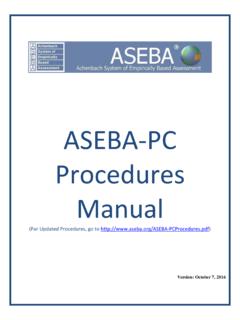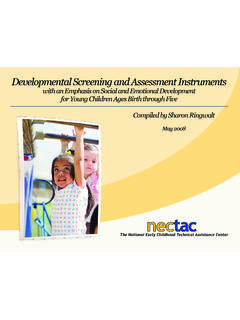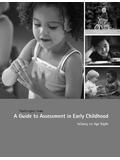Transcription of Manual for the ASEBA Brief Problem Monitor™ for Ages 6-18 ...
1 OverviewThe BPM/6-18 provides normed multi-informant monitoring of children s functioning & responses to interventions (RTIs)Parallel Multi-Informant BPM Forms Separate forms are completed in 1 to 2 minutes by parent figures (BPM-P),teachers (BPM-T), & youths (BPM-Y) Internalizing, Attention Problems, Externalizing, & Total Problems scales Parallel items & scales on the BPM/6-18 & the CBCL/6-18, TRF, & YSR enableusers to link comprehensive initial & outcome assessments to BPM/6-18 scores Users can add items for assessing strengths & problems Completed at user-selected intervals of days, weeks, monthsNormed Scale Scores Norms for each gender at ages 6-11 & 12-18 (BPM-P & BPM-T) or 11-18 (BPM-Y) Separate norms for parent, teacher, & self-ratings User-selected multicultural norms for dozens of societiesComputer Output Computer output compares item ratings & normed scale scores from up to 4 infomants Trajectories of normed scale scores are displayed across multiple occasionsCopyright 2011 & 2017 for the ASEBAB rief Problem Monitor for Ages 6-18(BPM/6-18) Achenbach, McConaughy, Ivanova, & RescorlaResearch Center for Children, Youth, and FamiliesUniversity of VermontContentsUse of the BPM-P, BPM-T, and BPM-Y in a Residential of the BPM-P and BPM-T by a Research Team.
2 9 References ..10 Appendix A. Directions for Using the BPM/6-18 ..11 Appendix B. Development of the BPM/6-18 ..11 Appendix C. Test-Retest Reliability and Internal Consistency ..12 Appendix D. Criterion-Related Validity ..13 Appendix E. Cross-Informant Correlations ..14 What is the BPM/6-18? ..2 Who Completes the BPM/6-18? ..2 How to Use the BPM/6-18 ..2 Comprehensive Initial and Outcome Assessments ..6 Age, Gender, Informant, and Multicultural Norms ..6 Illustrations of the BPM/6-18 Applications ..6 Use of the BPM-T by a School Psychologist ..6 Use of the BPM-P and BPM-Y by aMental Health Provider ..7 2 INT, ATT, and EXT ratings are summed to yield the T otal Problems (TOT) an informant completes the BPM, the ratings are entered into the BPM software pro-gram. The output includes bar graphs that pro-vide side-by-side displays of scale scores obtained from ratings by 1 to 4 informants on each occa-sion. As detailed in the Directions (Appendix A), each rating occasion is designated by a Rating Pe-riod #.
3 As illustrated in Figure 2, the bars indicate standard scores (T scores) based on norms for the child s age and gender, the type of informant, and user-selected multicultural norms (explained lat-er). The broken line across the bar graphs marks T scores of 65 (93rd percentile for normative samples of children). T scores <65 are considered to be in the normal range. T scores >65 are sufficiently el-evated to be of concern. By looking at the bars, users can quickly identify scales on which infor-mants ratings agree on Problem levels in the nor-mal vs. elevated range and scales on which infor-mants ratings lowest T score on all scales is 50 (50th percentile for normative samples). The T scores are truncated at 50 to prevent overinterpretation of differences among scores that are in the low nor-mal range, indicating very low levels of problems. The highest T score is 75 ( percentile) on the INT, ATT, and EXT scales. On the TOT scale, the highest T score is 80 ( percentile), which al-lows extra differentiation among high scores that are based on all the BPM versions of the items comprising each scale are listed beneath the bar graphs, along with each informant s 0-1-2 ratings.
4 The 0-1-2 rat-ings enable users to identify items on which infor-mants agree or software can also print line graphs that display trajectories of scale scores across rating periods. Figure 3 illustrates trajectories of BPM-T scores. These trajectories enable users to iden-tify scales on which a child s problems improve, worsen, or stay the same, according to ratings by each informant. In addition, the software can dis-play scale scores from each informant s ratings for each Rating Period, plus ratings of up to three user-specified problems and/or is the BPM/6-18?Completed in 1 to 2 minutes, the BPM/6-18 is a rating form for monitoring children s function-ing and responses to interventions (RTIs). (From here on, we will use BPM to refer to the BPM/6-18.) The BPM can also be used to compare chil-dren s responses to different intervention and con-trol BPM includes items for rating Internal-izing (INT), Attention (ATT), and Externalizing (EXT) problems over user-selected rating intervals ( , 5, 7, 14, 30, 45 days).
5 The items are drawn from the Child Behavior Checklist for Ages 6-18 (CBCL/6-18), Teacher s Report Form (TRF), and Youth Self-Report (YSR) (Achenbach & Rescorla, 2001). Each item is rated 0 = not true, 1 = some-what true, or 2 = very true. Users can add problems and/or strengths not already on the BPM, such as those that are especially targeted for A has directions for using the BPM. Appendix B details the development of the BPM, while Appendices C-E provide psychometric Completes the BPM?Separate forms are designed for completion by parents (BPM-P), teachers (BPM-T), and 11- to 18-year-old youths (BPM-Y). Other informants such as family members, staff in residential, in-patient, and detention facilities, school personnel, observers, and practitioners can also complete the BPM-P and BPM-T. Many children younger than 11 may be able to complete the BPM-Y. The forms can be self-administered or administered by interviewers in person or by telephone. Worded ap-propriately for the intended informant, each form of the BPM assesses the same 18 items.
6 However, the BPM-P and BPM-Y have an additional item for disobedience at home, which would not be ap-propriate for the to Use the BPMF igure 1 displays the BPM-P. Spaces are provided for writing in additional problems and strengths, as well as comments for each item. The superscripts INT, ATT, and EXT in Figure 1 in-dicate items whose 0-1-2 ratings are summed to yield scores for each BPM scale. (The superscripts are not printed on the actual BPM forms.) All the 3 Figure 1. The BPM-P. Superscripts indicate the items scored on the INT, ATT, and EXT scales, which are summed to yield the TOT score. (Superscripts are not printed on the actual form.)4 Figure 2. Bar graphs indicating scale scores from BPM-P, BPM-T, and BPM-Y forms completed by Adam s mother, father, and teacher, and by 3. Trajectories of BPM-T scale scores over 10 rating periods. Trajectories can be displayed for 2 to 10 rating Comprehensive Initial and Outcome AssessmentsThe CBCL/6-18, TRF, and/or YSR provide more comprehensive assessments than are pos-sible with Brief forms such as the BPM.
7 Inter-views with children and parents, tests, develop-mental histories, and medical examinations may also be relevant in many cases. It is strongly rec-ommended that comprehensive assessments be used to design interventions. The BPM is then used to assess responses to the of outcomes should also be sufficiently comprehensive to permit detailed comparisons of children s post-intervention functioning with their initial functioning. For example, if the CBCL/6-18, TRF, and/or YSR are among the initial assessments, users can re-administer them to evaluate outcomes in terms of changes in many items and , Gender, Informant, and Multicultural NormsThe bar graphs in Figure 2 and the trajectory graphs in Figure 3 display BPM scales in terms of scale scores that are based on norms for a child s age and gender, as rated by parents (BPM-P), teachers (BPM-T), or 11- to 18-year-olds (BPM- Y). If the user does not select particular multicul-tural norms, the default norms are based on a national sample (Achenbach & Rescorla, 2001).
8 Multicultural norms are available for many societies (Achenbach & Rescorla, 2015). Societies having BPM-P, BPM-T, and BPM-Y norms are listed at For example, if a parent from Society A fills out the BPM-P, the user can have the software display the BPM-P scale scores in terms of scale scores that are appropriate for the child s age and gen-der, as rated by parents from Society A. If the child attends a school, the user can have the software display the BPM-T scale scores in terms of scale scores that are appropriate for the child s age and gender, as rated by teach-ers. And if the child is old enough to complete the BPM-Y and is somewhat acculturated to the , the user can have the software display the BPM-Y scores in terms of scale scores that are appropriate for the child s age and gender, as rat-ed by 11- to 18-year-olds in Society A and then by 11- to 18-year-olds in the if an informant is from a society that is not listed at Extensive re-search has shown that normative scores from all societies analyzed to date fall into three groups: Compared to all the societies analyzed, Group 1 has relatively low Problem scores; Group 2 has intermediate scores; and Group 3 has rela-tively high scores.
9 If an informant comes from a society that is not listed, the user can elect to have the BPM/6-18 scales displayed in terms of the default scores ( norms, which serve as the Group 2 norms). As an alternative, the user can have the BPM scales displayed in terms of scores appropriate for a society that is similar to the informant s of BPM ApplicationsThe BPM can be used in many ways and un-der many conditions. The following illustrations exemplify applications by a school psychologist, a mental health provider, staff in a residential facil-ity, and a research team. All names and other per-sonal identifying information are fictitious. In the case studies, CBCL refers to the of the BPM-T by a School Psychologist. Third-grade teacher Dorothy Randall contacted her school psychologist for help with a student named Robby, who was disrupting her class. After Robby s parents consented to an evalua-tion, the school psychologist asked each parent to complete the CBCL and asked Ms. Randall to complete the TRF.
10 The school psychologist also reviewed Robby s test scores and grades, which were mostly in the low average range. Com-ments from Robby s previous teachers indicated moderate behavior profile scored from the TRF completed by Ms. Randall yielded scores well up in the clinical range on the Aggressive Behavior, Ex-ternalizing, and DSM-oriented Oppositional Defiant Problems scales. Robby s scores on the TRF Social Problems and Attention Problems syndromes were in the borderline clinical range, while his scores on the other Problem scales were in the normal range. His Academic Perfor-mance and Adaptive Functioning scores were in the borderline clinical range, with an especially low rating for Behaving the profiles scored from the CBCLs completed by Robby s parents, the School scale of the competence profile and the Aggressive Behavior scale were in the borderline clinical range, but all other scales were in the normal range. The parents responses to the CBCL s open-ended questions indicated that they did not feel any need for help with Robby s behavior outside school.








